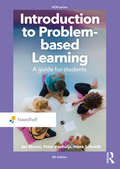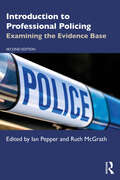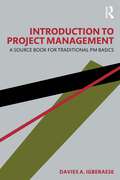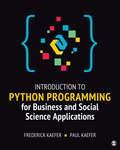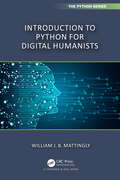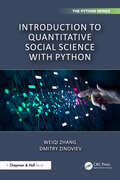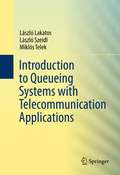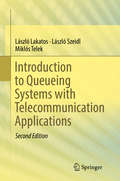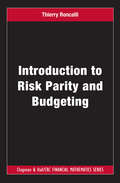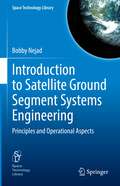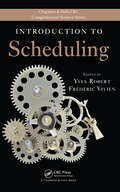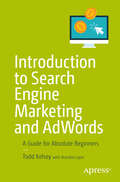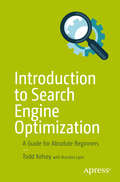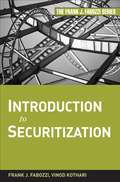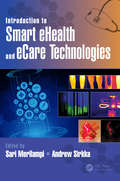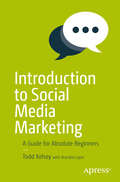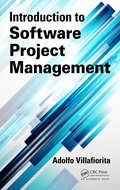- Table View
- List View
Introduction to Problem-Based Learning (Routledge-Noordhoff International Editions)
by Henk Schmidt Jos Moust Peter BouhuijsIntroduction to Problem-based Learning teaches students how to work with the problem-based learning method, which requires mainly self-directed learning. Particular attention is given to the necessary skills to apply this method effectively. Why Introduction to Problem-based Llearning? • comprehensible introduction in the problem-based learning method • enables students to experience the full potential of this concept • discusses the use of digital devices Introduction to Problem-based learning provides students with the necessary skills to operate within as well as outside problem-based groups. It discusses issues like: How do you take on a problem? How do you collaborate with others? How do you deal with cultural diversity? How do you lead a tutorial group? How can you organize your studies best? Special attention is given to the use of computers, tablets and internet in a problem-based environment.
Introduction to Professional Policing: Examining the Evidence Base
by Ian PepperPolicing is a dynamic profession with increasing demands and complexities placed upon police officers, staff and volunteers who provide a 24-hour service across a diverse range of communities. Written by experts in policing higher education from across both academic and professional practice, this book equips aspiring or newly appointed police officers, staff and volunteers with the knowledge and understanding to deal with the significant and often complex challenges they face daily.This second edition of Introduction to Professional Policing explores a number of the core underpinning knowledge requirements identified as themes within the ever-evolving National Policing Curriculum (NPC) and Police Constable Entry Routes (PCER), while also informing those embarking on leadership development. These include: Community and neighbourhood policing Counter-terrorism Digital policing Ethics, equality, diversity and inclusion Evidence-based policing Maintaining professional standards Police leadership Problem solving and problem-oriented policing Victims and protecting the vulnerable Volunteers in policing This edition has been reviewed and significantly updated in line with the dynamic and ongoing demands faced by operational policing and therefore the associated knowledge requirements for policing education and training. The book is refocused on the learning requirements contained within the range of entry routes now available in to policing, as well as the professional development of those serving as police staff and volunteers. This includes new chapters providing insights into community and neighbourhood policing, problem solving and volunteers in policing.At the end of each chapter the student finds a case study, reflective questions and an extensive reference list, all of which reinforces students’ knowledge and furthers their professional development. Written in a clear and direct style, this book supports aspiring police officers, newly appointed police officers, direct entry detectives, community support officers, special constables and police staff. It will also be of interest to those embarking on a leadership journey within policing and anyone wanting to learn more about the profession of policing. It is essential reading for students taking a professional policing degree or commencing any of the police constable entry routes.
Introduction to Project Finance in Renewable Energy Infrastructure: Including Public-Private Investments and Non-Mature Markets
by Farid MohamadiWhat is project finance? What makes project or structured finance so relevant for large renewable energy infrastructure? Which vocabulary do I need to know in order to speak the same language during meetings with lawyers, investors, bankers and engineers? These questions and many more are answered throughout this book, offering real world examples to bridge the gap between theory and practice. The book details the role of each stakeholder in the development of renewable energy projects, the interconnection between all the agreements, the financial process from fundraising to financial close, the processes of due diligence, risk analysis, project investment valuation and much more. It also provides with an introduction to Portfolio Management using renewable energy assets and an explanation of the role of Climate Finance in green energy investments. The commented glossary enables readers to unpick the jargon used in project finance for renewable energy, and the numerous creative figures and comprehensive tables aid with understanding. Offering a complete picture of the discipline, Introduction to Project Finance in Renewable Energy Infrastructure will be of value to professionals, engineers and academics alike interested in understanding the process and components of project finance in renewable energy infrastructures, in both private and public-private contexts.
Introduction to Project Management: A Source Book for Traditional PM Basics
by Davies A. IgberaeseThis book presents the fundamentals of project management in simple language and an easy-to-understand format. It is targeted principally at those who are learning or desiring to learn project management as well as those who are already taking project management as a course of study or as a profession. It covers all the basic aspects of project management including the core areas prescribed by the Project Management Institute (PMI) in the Project Management Body of Knowledge (PMBOK) sixth edition. Although the PMBOK Guide seventh edition has significantly shifted focus from a process based standard to a principle based standard, it does not invalidate nor replace the detailed knowledge base contained in the sixth edition, which substantially emphasizes project management processes and knowledge areas. This is particularly apt for the traditional approach to project delivery, which is predictive in nature and has the bulk of the planning done upfront. The sections of the book are arranged in order of Project Management Processes as they fall within the respective Project Management Knowledge Areas. Experienced project manager, Davies Igberaese, presents all the basic content of traditional project management in a straightforward practical sequence as a typical project manager would go about the processes of initiating, planning, executing, monitoring, and closing a project without losing sight of the iterative nature of project management. The inclusion of Project Management Templates gives students and other users of the book the confidence required to effectively understand the basics of managing a wide variety of projects across disciplines including construction, building, industrial engineering, petroleum engineering, software engineering, information technology, business administration, and event management. Introduction to Project Management: A Source Book for Traditional PM Basics can serve as a core textbook for academic courses in project management, for preparing for PMP and CAPM Certification exams, as an excellent resource for new project managers, as well as a handy reference book for project sponsors.
Introduction to Property Valuation in Australia
by David ParkerThis book provides an easy-to-follow introduction to the principal methods of property valuation in Australia within the context of International Valuation Standards, so bridging the gap between traditional property valuation methods and the modern era of global valuation governance. Providing a framework for valuation practice, the book outlines the property asset class, the role of valuation, concepts of value and valuation standards before focusing on the instructing, undertaking and reporting aspects of the valuation process. The market approach to valuation is addressed through the comparative method of valuation with the income approach addressed through the capitalisation of income, discounted cash flow and profits methods of valuation and the cost approach addressed through the replacement cost, reproduction cost and residual or hypothetical development methods of valuation. As an introductory textbook on property valuation methods, this book is a companion to Australia’s leading advanced valuation textbook, Principles and Practice of Property Valuation in Australia edited by the same author and also published by Routledge, which is a more advanced text considering key principles underlying property valuation and current techniques and issues in the practice of property valuation for major sectors of the Australian property market. The most up-to-date valuation text book for the Australian market, this book will appeal to both valuation practitioners and undergraduate/postgraduate students as well as to accountants, auditors, lawyers, lenders and all professionals dealing with property valuation issues.
Introduction to Psychometric Theory
by George A. Marcoulides Tenko RaykovThis new text provides a state-of the-art introduction to educational and psychological testing and measurement theory that reflects many intellectual developments of the past two decades. The book introduces psychometric theory using a latent variable modeling (LVM) framework and emphasizes interval estimation throughout, so as to better prepare readers for studying more advanced topics later in their careers. Featuring numerous examples, it presents an applied approach to conducting testing and measurement in the behavioral, social, and educational sciences. Readers will find numerous tips on how to use test theory in today's actual testing situations. To reflect the growing use of statistical software in psychometrics, the authors introduce the use of Mplus after the first few chapters. IBM SPSS, SAS, and R are also featured in several chapters. Software codes and associated outputs are reviewed throughout to enhance comprehension. Essentially all of the data used in the book are available on the website. In addition instructors will find helpful PowerPoint lecture slides and questions and problems for each chapter. The authors rely on LVM when discussing fundamental concepts such as exploratory and confirmatory factor analysis, test theory, generalizability theory, reliability and validity, interval estimation, nonlinear factor analysis, generalized linear modeling, and item response theory. The varied applications make this book a valuable tool for those in the behavioral, social, educational, and biomedical disciplines, as well as in business, economics, and marketing. A brief introduction to R is also provided. Intended as a text for advanced undergraduate and/or graduate courses in psychometrics, testing and measurement, measurement theory, psychological testing, and/or educational and/or psychological measurement taught in departments of psychology, education, human development, epidemiology, business, and marketing, it will also appeal to researchers in these disciplines. Prerequisites include an introduction to statistics with exposure to regression analysis and ANOVA. Familiarity with SPSS, SAS, STATA, or R is also beneficial. As a whole, the book provides an invaluable introduction to measurement and test theory to those with limited or no familiarity with the mathematical and statistical procedures involved in measurement and testing.
Introduction to Python Programming for Business and Social Science Applications
by Paul Kaefer Frederick KaeferWould you like to gather big datasets, analyze them, and visualize the results, all in one program? If this describes you, then Introduction to Python Programming for Business and Social Science Applications is the book for you. Authors Frederick Kaefer and Paul Kaefer walk you through each step of the Python package installation and analysis process, with frequent exercises throughout so you can immediately try out the functions you’ve learned. Written in straightforward language for those with no programming background, this book will teach you how to use Python for your research and data analysis. Instead of teaching you the principles and practices of programming as a whole, this application-oriented text focuses on only what you need to know to research and answer social science questions. The text features two types of examples, one set from the General Social Survey and one set from a large taxi trip dataset from a major metropolitan area, to help readers understand the possibilities of working with Python. Chapters on installing and working within a programming environment, basic skills, and necessary commands will get you up and running quickly, while chapters on programming logic, data input and output, and data frames help you establish the basic framework for conducting analyses. Further chapters on web scraping, statistical analysis, machine learning, and data visualization help you apply your skills to your research. More advanced information on developing graphical user interfaces (GUIs) help you create functional data products using Python to inform general users of data who don’t work within Python. First there was IBM® SPSS®, then there was R, and now there′s Python. Statistical software is getting more aggressive - let authors Frederick Kaefer and Paul Kaefer help you tame it with Introduction to Python Programming for Business and Social Science Applications.
Introduction to Python Programming for Business and Social Science Applications
by Paul Kaefer Frederick KaeferWould you like to gather big datasets, analyze them, and visualize the results, all in one program? If this describes you, then Introduction to Python Programming for Business and Social Science Applications is the book for you. Authors Frederick Kaefer and Paul Kaefer walk you through each step of the Python package installation and analysis process, with frequent exercises throughout so you can immediately try out the functions you’ve learned. Written in straightforward language for those with no programming background, this book will teach you how to use Python for your research and data analysis. Instead of teaching you the principles and practices of programming as a whole, this application-oriented text focuses on only what you need to know to research and answer social science questions. The text features two types of examples, one set from the General Social Survey and one set from a large taxi trip dataset from a major metropolitan area, to help readers understand the possibilities of working with Python. Chapters on installing and working within a programming environment, basic skills, and necessary commands will get you up and running quickly, while chapters on programming logic, data input and output, and data frames help you establish the basic framework for conducting analyses. Further chapters on web scraping, statistical analysis, machine learning, and data visualization help you apply your skills to your research. More advanced information on developing graphical user interfaces (GUIs) help you create functional data products using Python to inform general users of data who don’t work within Python. First there was IBM® SPSS®, then there was R, and now there′s Python. Statistical software is getting more aggressive - let authors Frederick Kaefer and Paul Kaefer help you tame it with Introduction to Python Programming for Business and Social Science Applications.
Introduction to Python for Humanists (Chapman & Hall/CRC The Python Series)
by William MattinglyThis book will introduce digital humanists at all levels of education to Python. It provides background and guidance on learning the Python computer programming language, and as it presumes no knowledge on the part of the reader about computers or coding concepts allows the reader to gradually learn the more complex tasks that are currently popular in the field of digital humanities. This book will be aimed at undergraduates, graduates, and faculty who are interested in learning how to use Python as a tool within their workflow. An Introduction to Python for Digital Humanists will act as a primer for students who wish to use Python, allowing them to engage with more advanced textbooks. This book fills a real need, as it is first Python introduction to be aimed squarely at humanities students, as other books currently available do not approach Python from a humanities perspective. It will be designed so that those experienced in Python can teach from it, in addition to allowing those who are interested in being self-taught can use it for that purpose.Key Features: Data analysis Data science Computational humanities Digital humanities Python Natural language processing Social network analysis App development
Introduction to Quantitative Methods for Financial Markets
by Andreas Binder Hansjoerg Albrecher Volkmar Lautscham Philipp MayerSwaps, futures, options, structured instruments - a wide range of derivative products is traded in today's financial markets. Analyzing, pricing and managing such products often requires fairly sophisticated quantitative tools and methods. This book serves as an introduction to financial mathematics with special emphasis on aspects relevant in practice. In addition to numerous illustrative examples, algorithmic implementations are demonstrated using "Mathematica" and the software package "UnRisk" (available for both students and teachers). The content is organized in 15 chapters that can be treated as independent modules. In particular, the exposition is tailored for classroom use in a Bachelor or Master program course, as well as for practitioners who wish to further strengthen their quantitative background.
Introduction to Quantitative Social Science with Python (Chapman & Hall/CRC The Python Series)
by Weiqi Zhang Dmitry ZinovievDeparting from traditional methodologies of teaching data analysis, this book presents a dual-track learning experience, with both Executive and Technical Tracks, designed to accommodate readers with various learning goals or skill levels. Through integrated content, readers can explore fundamental concepts in data analysis while gaining hands-on experience with Python programming, ensuring a holistic understanding of theory and practical application in Python.Emphasizing the practical relevance of data analysis in today's world, the book equips readers with essential skills for success in the field. By advocating for the use of Python, an open-source and versatile programming language, we break down financial barriers and empower a diverse range of learners to access the tools they need to excel.Whether you're a novice seeking to grasp the foundational concepts of data analysis or a seasoned professional looking to enhance your programming skills, this book offers a comprehensive and accessible guide to mastering the art and science of data analysis in social science research.Key Features: Dual-track learning: Offers both Executive and Technical Tracks, catering to readers with varying levels of conceptual and technical proficiency in data analysis. Includes comprehensive quantitative methodologies for quantitative social science studies. Seamless integration: Interconnects key concepts between tracks, ensuring a smooth transition from theory to practical implementation for a comprehensive learning experience. Emphasis on Python: Focuses on Python programming language, leveraging its accessibility, versatility, and extensive online support to equip readers with valuable data analysis skills applicable across diverse domains.
Introduction to Queueing Systems with Telecommunication Applications
by Laszlo Lakatos Miklos Telek Laszlo SzeidlThe book is composed of two main parts: mathematical background and queueing systems with applications. The mathematical background is a self containing introduction to the stochastic processes of the later studies queueing systems. It starts with a quick introduction to probability theory and stochastic processes and continues with chapters on Markov chains and regenerative processes. More recent advances of queueing systems are based on phase type distributions, Markov arrival processes and quasy birth death processes, which are introduced in the last chapter of the first part. The second part is devoted to queueing models and their applications. After the introduction of the basic Markovian (from M/M/1 to M/M/1//N) and non-Markovian (M/G/1, G/M/1) queueing systems, a chapter presents the analysis of queues with phase type distributions, Markov arrival processes (from PH/M/1 to MAP/PH/1/K). The next chapter presents the classical queueing network results and the rest of this part is devoted to the application examples. There are queueing models for bandwidth charing with different traffic classes, slotted multiplexers, ATM switches, media access protocols like Aloha and IEEE 802.11b, priority systems and retrial systems. An appendix supplements the technical content with Laplace and z transformation rules, Bessel functions and a list of notations. The book contains examples and exercises throughout and could be used for graduate students in engineering, mathematics and sciences.
Introduction to Queueing Systems with Telecommunication Applications
by László Lakatos László Szeidl Miklós TelekThe book is the extended and revised version of the 1st edition and is composed of two main parts: mathematical background and queueing systems with applications. The mathematical background is a self-containing introduction to the stochastic processes of the later studied queueing systems. It starts with a quick introduction to probability theory and stochastic processes and continues with chapters on Markov chains and regenerative processes. More recent advances of queueing systems are based on phase type distributions, Markov arrival processes and quasy birth death processes, which are introduced in the last chapter of the first part.The second part is devoted to queueing models and their applications. After the introduction of the basic Markovian (from M/M/1 to M/M/1//N) and non-Markovian (M/G/1, G/M/1) queueing systems, a chapter presents the analysis of queues with phase type distributions, Markov arrival processes (from PH/M/1 to MAP/PH/1/K). The next chapter presents the classical queueing network results and the rest of this part is devoted to the application examples. There are queueing models for bandwidth charing with different traffic classes, slotted multiplexers, media access protocols like Aloha and IEEE 802.11b, priority systems and retrial systems.An appendix supplements the technical content with Laplace and z transformation rules, Bessel functions and a list of notations. The book contains examples and exercises throughout and could be used for graduate students in engineering, mathematics and sciences.Reviews of first edition:"The organization of the book is such that queueing models are viewed as special cases of more general stochastic processes, such as birth-death or semi-Markov processes. … this book is a valuable addition to the queuing literature and provides instructors with a viable alternative for a textbook to be used in a one- or two-semester course on queueing models, at the upper undergraduate or beginning graduate levels."Charles Knessl, SIAM Review, Vol. 56 (1), March, 2014
Introduction to Real Estate Development and Finance
by Richard M. LevyThis book provides readers with a basic understanding of the principles that underlie real estate development. A brief historical overview and an introduction to basic principles are followed by examples from practice. Case studies focus on how cities change and respond to the economic, technological, social, and political forces that shape urban development in North America. It is important to have a framework for understanding the risks and rewards in real estate investing. In measuring return, consideration must be given to both investment appreciation and the cash flow generated over the life of a project. In addition, metrics are presented that can be useful in assessing the financial feasibility of a real estate development proposal. This book also provides an overview of the forces of supply and demand that gauge the potential market for a new project. In determining the size of “residual demand”, estimates for population growth, family formation, and new development are important. All development projects fall under the auspices of one or several jurisdictions. Though every jurisdiction has different rules and procedures, basic knowledge of the planning process is critical to the success of all development projects regardless of location. Furthermore, all projects have a legal component. Basic issues of land ownership, property rights, property transfer, and land registration are reviewed, all of which need to be considered when a property is sold or purchased. This book also provides a primary on the design and construction process. In constructing a building, a team of experts is first required to design the architectural, structural, and heating, ventilation, and air conditioning (HVAC) systems for a building. An overview is provided of each building system: wood, concrete, and steel. Critical to a successful real estate development, project management principles for the processes of design, bidding, and construction are explored, with close attention given to budgeting, scheduling, and resource management. Essential reading for anyone involved in the development of our built environment, this is a must-read introduction for students and professionals in architecture, urban planning, engineering or real estate seeking an approachable and broad view of real estate development and finance.
Introduction to Responsibility Accounting Systems
by Jacob Cohen David F. HawkinsIntroduces responsibility accounting systems.
Introduction to Risk Parity and Budgeting (Chapman and Hall/CRC Financial Mathematics Series)
by Thierry RoncalliAlthough portfolio management didn't change much during the 40 years after the seminal works of Markowitz and Sharpe, the development of risk budgeting techniques marked an important milestone in the deepening of the relationship between risk and asset management. Risk parity then became a popular financial model of investment after the global fina
Introduction to Satellite Ground Segment Systems Engineering: Principles and Operational Aspects (Space Technology Library #41)
by Bobby NejadThe ground segment is the fundamental backbone of every satellite project, yet it is usually not visible to the public or the end user of a satellite service. Also the bulk of existing published space literature tends to focus on the satellite or its subsystems. This book tries to fill this gap and addresses systems engineering concepts applied to the design, development, qualification, and deployment of the ground control segment required to operate a single satellite, a constellation, or even a manned space vehicle. The domain of ground segment engineering has significantly evolved in recent years, mainly driven by major advances in the IT sector. Hardware virtualisation or the availability of on-demand cloud computing services are typical examples of new technologies that have changed fundamental architectural concepts previously standard in heritage ground segments. Furthermore, the stark increase of cyber attacks - today a major risk to almost all critical IT based infrastructure - has made a cyber threat resilient architecture to become one of the indispensable design requirements for ground segment engineers. The new mega constellations recently put into space deploying up to several hundred of flying objects have put very demanding needs on the ground segment for automated satellite operations. These topics and more are addressed in the book’s chapters, along with a detailed explanation of the most relevant components of a typical ground segment architecture. The basic functional requirements, design features, and the most important ground and space segment interfaces are addressed and explained in detail, supported by a wealth of figures for easier understanding. This book is kept at an introductory level, allowing newcomers to get familiar with this fairly complex subject matter. It is therefore suitable for graduate students, but can equally serve as a valuable source of information for already experienced space engineers who seek to gain a deeper understanding of the ground segment infrastructure and related systems engineering processes. It can also help project managers to better interact with their systems engineers, satellite developers to define their ground segment interfaces, and satellite operators to improve their flight and ground procedures. It is very well suited for everyone intending to start a career in satellite ground segment systems engineering.
Introduction to Scheduling (Chapman & Hall/CRC Computational Science)
by Yves Robert Frédéric VivienFull of practical examples, Introduction to Scheduling presents the basic concepts and methods, fundamental results, and recent developments of scheduling theory. With contributions from highly respected experts, it provides self-contained, easy-to-follow, yet rigorous presentations of the material.The book first classifies scheduling problems and
Introduction to Search Engine Marketing and AdWords: A Guide For Absolute Beginners
by Todd KelseyUse Google's AdWords to create your ads. Each chapter goes beyond the tool itself, discussing helpful resources and important issues to keep in mind. If you are completely new to search engine marketing and AdWords and you want to learn the basics, this guide will introduce you to the content quickly. Introduction to Search Engine Marketing and AdWords is not in-depth, comprehensive, or trying to cover every tool or platform--an impossible task! But it is an easy-to-understand introduction to the most important tools and skills in search engine marketing. What You'll Learn Take a behind-the-scenes tour of AdWords, including how to create an account Create and launch a campaign as well as ads, including keyword tools Monitor a campaign, including time frame, clicks and CTR, and reporting Implement various campaign strategies, including support email and dealing with errors Use Ad extensions as well as site links Who This Book Is For Those who need to get up to speed on search engine marketing tools and techniques for business or personal use. This book is also suitable as a student reference.
Introduction to Search Engine Optimization: A Guide For Absolute Beginners
by Todd KelseyDon't be intimidated by all the search engine optimization (SEO) tools out there. You will start out learning about keywords and the importance of quality content and then walk through incremental steps as you try out the tools and master the tips and strategies. If you are completely new to search engine optimization and you want to learn the basics, this guide will introduce you to the content quickly. Introduction to Search Engine Optimization is a detailed guide to the most important tools and skills needed to accurately and effectively utilize search engine optimization. This book covers SEO basics, keyword research, SEO ranking and analytics, Google Analytics, and more. It also includes an overview of how to pursue SEO-related certifications. What You'll Learn Create a content platform, including blogs and YouTube channels Use keywords to maximize findability and increase search volume Check your SEO rank and other analytics Hunt for duplicate content Set up Google Analytics, including Blogger Utilize Indexing and Webmaster tools/search console Who This Book Is For Those who need to get up to speed on search engine optimization tools and techniques for business or personal use. This book is also suitable as a student reference.
Introduction to Securitization
by Frank J. Fabozzi Vinod KothariIntroduction to Securitization outlines the basics of securitization, addressing applications for this technology to mortgages, collateralized debt obligations, future flows, credit cards, and auto loans. The authors present a comprehensive overview of the topic based on the experience they have gathered through years of interaction with practitioners and graduate students around the world. The authors offer coverage of such key topics as: structuring agency MBS deals and nonagency deals, credit enhancements and sizing, using interest rate derivatives in securitization transactions, asset classes securitized, operational risk factors, implications for financial markets, and applying securitization technology to CDOs. Finally, in the appendices, the authors provide an essential introduction to credit derivatives, an explanation of the methodology for the valuation of MBS/ABS, and the estimation of interest rate risk.Securitization is a financial technique that pools assets together and, in effect, turns them into a tradable security. The end result of a securitization transaction is that a corporation can obtain proceeds by selling assets and not borrowing funds. In real life, many securitization structures are quite complex and enigmatic for practitioners, investors, and finance students. Typically, books detailing this topic are either too lengthy, too technical, or too superficial in their presentation. Introduction to Securitization is the first to offer essential information on this topic at a fundamental, yet comprehensive level-providing readers with a working understanding of what has become one of today's most important areas of finance.Authors Frank Fabozzi and Vinod Kothari, internationally recognized experts in the field, clearly define securitization, contrast it with corporate finance, and explain its advantages. They carefully illustrate the structuring of asset-backed securities (ABS) transactions, including agency mortgage-backed securities (MBS) deals and nonagency deals, and show the use of credit enhancements and interest rate derivatives in such transactions. They review the collateral classes in ABS, such as retail loans, credit cards, and future flows, and discuss ongoing funding vehicles such as asset-backed commercial paper conduits and other structured vehicles. And they explain the different types of collateralized debt obligations (CDOs) and structured credit, detailing their structuring and analysis. To complement the discussion, an introduction to credit derivatives is also provided.The authors conclude with a close look at securitization's impact on the financial markets and the economy, with a review of the now well-documented problems of the securitization of one asset class: subprime mortgages. While questions about the contribution of securitization have been tainted by the subprime mortgage crisis, it remains an important process for corporations, municipalities, and government entities seeking funding. The significance of this financial innovation is that it has been an important form of raising capital for corporations and government entities throughout the world, as well as a vehicle for risk management. Introduction to Securitization offers practitioners and students a simple and comprehensive entry into the interesting world of securitization and structured credit.
Introduction to Smart eHealth and eCare Technologies (Devices, Circuits, and Systems #63)
by Sari Merilampi Andrew SirkkaBoth the demographics and lack of resources in the health and well-being industry are increasingly forcing us to find alternative solutions for individualized health and social care. In an effort to address this issue, smart technologies present enormous potential in solving this challenge. This book strives to enhance communication and collaboration between technology and health and social care sectors. The reader will receive an extensive overview of the possibilities of various technologies in care sectors (including ICT, electronics, automation, and sensor technology) written by experts from various countries. <P><P>It will prove extremely useful for engineers developing well-being related systems, software, or other devices that can be used by professionals working with people with specialist needs, well-being and health service providers, educators teaching related courses, and upper level undergraduate students and graduate student studying related topics. The technology focus of the book is widespread and addresses elderly care and hospitals, in addition to solutions for various user groups, devices, and technologies. Beyond serving as a resource for nurses and people working in care sector, the book is also meant to give guidelines for engineers developing person-centered systems by exploring the integration of these technologies into service systems.
Introduction to Social Housing
by Paul ReevesThe provision and management of social housing for those who are unable to access the housing market is essential to the maintenance of the fabric of society. The social housing industry is vast and still growing. There are very few countries in the world where some form of subsidised housing does not exist, and the total number of social homes is likely to grow worldwide, as are the challenges of the sector.Paul Reeves takes a people-centred approach to the subject, describing the themes that have run through provision of social housing from the first philanthropic industrialists in the 19th Century though to the increasingly complex mixture of ownerships and tenures in the present day. The management of housing forms a key part of the book, with an emphasis on the practical aspects of tenant participation and multi-agency working.The book is ideal for students of housing and social policy, and for housing professionals aiming to obtain qualifications and wanting a broad understanding of the social housing sector.
Introduction to Social Media Marketing: A Guide For Absolute Beginners
by Todd KelseyEasily understand the most important tools and skills in social media marketing. You'll be exposed to Facebook pages and ads, work with Twitter and LinkedIn, save time with Hootsuite, and learn social media monitoring. If you are completely new to social media marketing and you want to learn the basics, this guide will introduce you to the content quickly. Introduction to Social Media Marketing has a particular focus on ROI (return on investment), to help you think critically about the value social media could bring a business or organization. You'll explore the question of whether or not it's worth it to invest time and money in each social media channel. What You'll Learn Understand basic functions for most social media tools, including how to get up and running See the benefits of social media tools and which one you should use for specific purposes Calculate the real ROI expected from using specific tools Utilize social media monitoring and analytics Who This Book Is For Those who need to get up to speed on a broad range of social media tools and techniques for business or personal use. This book is also suitable as a student reference.
Introduction to Software Project Management
by Adolfo VillafioritaAlthough software development is one of the most complex activities carried out by man, sound development processes and proper project management can help ensure your software projects are delivered on time and under budget. Providing the know-how to manage software projects effectively, Introduction to Software Project Management supplies an acces
